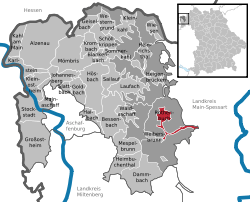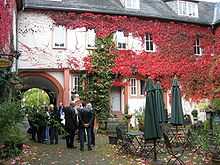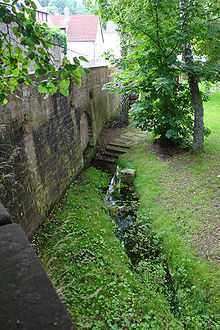Rothenbuch
| Rothenbuch | ||
|---|---|---|
| ||
 Rothenbuch | ||
Location of Rothenbuch within Aschaffenburg district  | ||
| Coordinates: 49°58′N 9°24′E / 49.967°N 9.400°ECoordinates: 49°58′N 9°24′E / 49.967°N 9.400°E | ||
| Country | Germany | |
| State | Bavaria | |
| Admin. region | Unterfranken | |
| District | Aschaffenburg | |
| Government | ||
| • Mayor | Gerhard Aulenbach (SPD) | |
| Area | ||
| • Total | 7.05 km2 (2.72 sq mi) | |
| Elevation | 365 m (1,198 ft) | |
| Population (2012-12-31)[1] | ||
| • Total | 1,714 | |
| • Density | 240/km2 (630/sq mi) | |
| Time zone | CET/CEST (UTC+1/+2) | |
| Postal codes | 63860 | |
| Dialling codes | 06094 | |
| Vehicle registration | AB | |
| Website | www.rothenbuch.de | |
Rothenbuch is a community in the Aschaffenburg district in the Regierungsbezirk of Lower Franconia (Unterfranken) in Bavaria, Germany.
Geography
Location
Rothenbuch lies in the Bavarian Lower Main (Bayerischer Untermain), in the heart of Germany’s biggest broadleaf woodland, the Spessart (range). Rothenbuch’s location between the Frankfurt Rhine Main Region, centred on Frankfurt, and the Würzburg region puts it within easy reach of either of these places. Frankfurt Airport can be reached in roughly 40 minutes, and the nearest InterCityExpress stop is the railway station at Aschaffenburg, twenty minutes away.
History
Rothenbuch is among the Inner Spessart’s oldest and most significant places.
In 1318, Rothenbuch had its first documentary mention in the words zuo den Rodenboychen when the Archbishop of Mainz, Peter of Aspelt and the Bishop of Würzburg, Gottfried III of Hohenlohe, concluded an agreement here dealing with coöperation on security questions.
In 1342, building work began on a palatial castle (Schloss) in Rothenbuch at the source of the Hafenlohr. The first castle dwellers may have indulged in the hunt.
In the German Peasants' War in 1525, the castle was heavily damaged or destroyed. In 1566, it was not only newly built but also expanded on Elector of Mainz Daniel Brendel von Homburg’s orders.
A first drawing of Rothenbuch is to be found on the oldest extant map of the Spessart, the so-called Pfinzigkarte from 1594
Rothenbuch achieved its greatest political importance when the Amtskellerei Rothenbuch, a financial and administrative authority for 14 places in the High Spessart, was established. In 1782, Rothenbuch was declared the seat of the Amtsvogtei.
The Electoral Mainz Amt passed along with this under the 1803 Reichsdeputationshauptschluss to the newly formed Principality of Aschaffenburg, with which it passed in 1814 (by this time it had become a department of the Grand Duchy of Frankfurt) to Bavaria.
On 3 June 1814, Rothenbuch became the seat of a Royal Bavarian Court. In 1879, the Court was dissolved and Rothenbuch was incorporated into the Bezirksamt and later District (Landkreis) of Lohr. In 1972, this district was abolished and Rothenbuch was grouped into the current Aschaffenburg district. From 1977 to 1993, Rothenbuch formed a Verwaltungsgemeinschaft (Administrative Community) with Waldaschaff and Weibersbrunn. On 1 January 1994, Rothenbuch regained its municipal autonomy.
Population development
Within the municipal area, 993 inhabitants were counted in 1900, 1,476 in 1950 and 1,975 in 2007.
Politics
Community council
The council is made up of 13 council members, counting the fulltime mayor.
| SPD | CSU | Freie Bürger | Total | |
| 2008 | 7 | 3 | 3 | 13 seats |
(as at municipal election held on 2 March 2008)
Mayor
Since 2002, the mayor has been Gerhard Aulenbach (SPD). At the municipal elections on 2 March 2008, he was confirmed in office with 97.5% of the vote.
Coat of arms
The community’s arms might be described thus: Party per fess, Or dexter a beech eradicated and sinister a stag’s attires gules, gules a wheel spoked of six argent.
The Wheel of Mainz refers to the slightly less than 500 years in which Rothenbuch belonged to the Archbishopric of Mainz. The beechtree and the hart’s antlers symbolize the forest and the hunt respectively.
Culture and sightseeing
Schloss Rothenbuch


The castle had its first mention in a document from 3 July 1318. Found today on the site is a former hunting castle that was built to Daniel Brendel von Homburg’s plans in 1567. The four-winged complex features a rectangular inner courtyard with a polygonal stair tower in the north wing. That the castle formerly had a moat can be clearly seen in the two access bridges. At the castle rises the Hafenlohr, which once filled the moat and also the nearby lakes that teemed with fish. The castle served as a central administrative seat in the Spessart and was for more than two centuries the lawcourt for 14 surrounding communities. Since 1994, the building has been used as a hotel.
Other attractions
- European cultural hiking path
- Heimatmuseum Altes Bauernhaus (local history museum)
- In the Rothenbuch Forest are found Germany’s most imposing stands of oak. The Heisterblock section of the woods is Central Europe’s biggest and oldest oak forest.
Nationally known and worth seeing is the “Historic Christmas Market” held on the first weekend in Advent, with more than 15,000 visitors. The Stadtzeitung Aschaffenburg (newspaper) described the Christmas Market as the nicest in the whole of the Bavarian Lower Main with the observation “Here Father Christmas feels right at home”.
Economy and infrastructure
Municipal tax revenue in 2007 amounted to €1,000,000, of which business taxes (net) made up €155,000. The community’s per capita debt amounted to 0.
Agriculture and forestry
According to official statistics, there were 47 workers on the social welfare contribution rolls working in agriculture and forestry in 1998. In producing businesses this was 118, and in trade and transport 25. In other areas, 48 workers on the social welfare contribution rolls were employed, and 665 such workers worked from home. There was one processing business. Five businesses were in construction (2 in the industry itself and 3 others in related fields), and furthermore, there are 2 agricultural operations with a meadowland area of 157 ha.
The statistics for 2003 show that there were 543 workers commuting to jobs elsewhere, whereas 111 commuted to jobs in the community.
Transport
Rothenbuch lies 7 km from Autobahn A 3 (Weibersbrunn interchange). Bundesstraße 26 from Aschaffenburg to Würzburg runs by 3 km from the community. Rothenbuch is served by buses from Aschaffenburg and Lohr.
Education
As of 1999, the following institutions were in the community:
- Kindergartens: 75 places with 61 children
- Primary schools: 1 with 5 teachers and 96 pupils
Other
Awards
- 2005 district winner in the contest Unser Dorf soll schöner werden - Unser Dorf hat Zukunft (“Our Village Should Become Lovelier – Our Village Has a Future”)
- 2006 2nd place in Lower Franconia contest Unser Dorf soll schöner werden
- 2006 district winner in the contest Lebendiges Grün in Stadt und Land (“Living Green in Town and Country”)
- 2006 “Nicest Christmas Market in the Bavarian Lower Main” (according to the Stadtzeitung Aschaffenburg newspaper)
- 2008 district winner in the contest Unser Dorf soll schöner werden - Unser Dorf hat Zukunft
References
- ↑ "Fortschreibung des Bevölkerungsstandes". Bayerisches Landesamt für Statistik und Datenverarbeitung (in German). 31 December 2012.
External links
| Wikimedia Commons has media related to Rothenbuch. |
- Community’s official webpage (German)
- This article incorporates information from the German Wikipedia.
